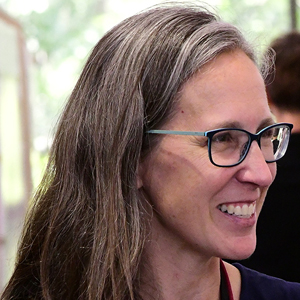Eleven new researchers received competitive NIEHS Revolutionizing Innovative, Visionary Environmental Health Research (RIVER) and Outstanding New Environmental Health Science (ONES) awards as of July 7.
The ONES award is geared towards researchers at formative stages of their careers. RIVER focuses on mid-career and established researchers.
 RIVER and ONES differ from the traditional approach of funding studies with specific aims outlined in the application and instead fund promising scientists.
RIVER and ONES differ from the traditional approach of funding studies with specific aims outlined in the application and instead fund promising scientists.Since the award programs began in 2017 and 2006, respectively, they have supported groundbreaking projects in environmental health sciences. This year, the institute will grant a total of $15 million over five years to the six ONES awardees. NIEHS committed approximately $32 million over eight years to support five new RIVER researchers.
“The RIVER award seeks scientists that have demonstrated the potential for continued innovative research, and supports the majority of their established independent research program,” said Jennifer Collins, RIVER coordinator for NIEHS. “Meanwhile, the ONES award identifies the most talented early stage investigators who intend to make a long-term commitment to environmental research and helps them launch an innovative research program.”
The RIVER grant focuses on broadly-stated goals of a research program, while the ONES is a research grant which will have specifically stated research aims. The difference between a ONES grant and a traditional NIH grant is that ONES awardees receive special funding specifically for career enhancement.
“In both the RIVER and ONES programs, grantees come from a variety of scientific disciplines, including genetics, toxicology, epidemiology, and neuroscience,” said Carol Shreffler, Ph.D., the ONES program officer. “The researchers are working on projects that reflect the breadth of the whole NIEHS grant program, from studying specific aspects of DNA damage, to better understanding how certain exposures can affect disease development and progression.”
Linking exposures and disease
 “The RIVER award allows researchers to move in new directions and devote more effort to scientific service and mentorship,” said Collins. (Photo courtesy of Steve McCaw)
“The RIVER award allows researchers to move in new directions and devote more effort to scientific service and mentorship,” said Collins. (Photo courtesy of Steve McCaw)Studying the link between exposures and adverse health effects can be challenging, and there is still much that scientists do not understand. ONES and RIVER researchers have dedicated their careers to better understanding this link through creative research that delves more deeply into specific exposures.
- ONES awardee Andres Cardenas, Ph.D., from the University of California, Berkeley, studies the extent to which exposures to neurotoxic mixtures just before and after birth, as well as key prenatal nutrients, can jointly influence brain development in childhood.
- Salik Hussain, Ph.D., ONES awardee from West Virginia University and former NIEHS postdoctoral fellow, uses a single exposure to better understand how lungs respond to air pollution, while comparing responses to a mixture of air pollution compounds.
- Amy Padula, Ph.D., from the University of California, San Francisco, will use her ONES award to study how mothers’ exposures to wildfire and intentional biomass burning during pregnancy may affect whether her baby is born prematurely.
- ONES awardee Jessica Plavicki, Ph.D., from Brown University, wants to understand how toxicant exposures may disrupt the development of a type of brain cell that is necessary for learning, memory, information processing, and behavior.
- Mary Rice, M.D., from Harvard University, received a ONES award for her research on how high-efficiency particulate air (HEPA) filters, which remove air pollution particles from indoor air, may improve symptoms of chronic obstructive pulmonary disease.
- Donna Zhang, Ph.D., from the University of Arizona, received a RIVER award to further study development of arsenic-related diseases — such as lung cancer and Type II diabetes. She hopes to identify new pharmaceuticals to treat arsenic-related health effects.
DNA takes center stage
 “ONES includes career enhancement budgets, investing in the awardees’ futures,” said Shreffler. (Photo courtesy of Steve McCaw)
“ONES includes career enhancement budgets, investing in the awardees’ futures,” said Shreffler. (Photo courtesy of Steve McCaw)A greater understanding of DNA’s role in health and disease will give new insight how specific genetic mechanisms can worsen diseases in the context of environmental exposures. Many of the 2020 awardees are working on this important aspect of human biology.
- Dana Dolinoy, Ph.D., from the University of Michigan, will use her RIVER award to identify changes in DNA, noncoding RNA, and gene expression after exposure to metals or plasticizers.
- With his ONES award, Shobhan Gaddameedhi, Ph.D., from Washington State University, will study the interplay of rotating shift work, circadian disruption, DNA repair, and increased risk of skin cancer.
- RIVER awardee Joann Sweasy, Ph.D., from the University of Arizona, researches the connection between DNA repair and the development of lupus, an autoimmune disease.
- Bennett Van Houten, Ph.D., from the University of Pittsburgh, received a RIVER award to use groundbreaking technologies to understand how common forms of DNA damage are detected and repaired in a living cell.
- Yinsheng Wang, Ph.D., from the University of California, Riverside, will study how alkylated DNA lesions affect DNA stability with his RIVER award. Alkylation, a type of damage that creates lesions in DNA, can alter gene expression and utlimately lead to disease.
(Sheena Scruggs, Ph.D., is the digital outreach coordinator in the NIEHS Office of Communications and Public Liaison.)


















